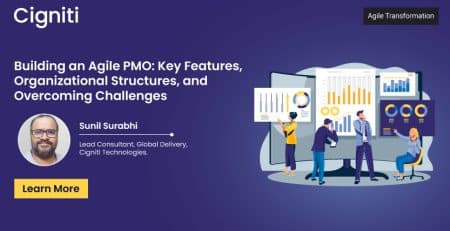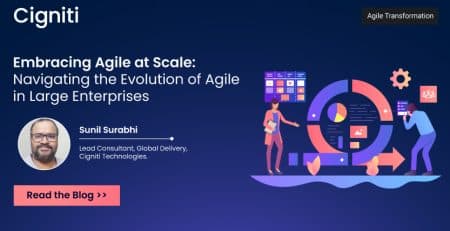Navigating the Agile Landscape: A Comparative Study of Scrum, Kanban, and Scrumban
|
Listen on the go!
|
In today’s dynamic and unpredictable business environment, enterprises are proactively adapting and optimizing their methods of operation to ensure swift time-to-market and the delivery of high-quality products. The focus lies in exploring and refining their work processes and methodologies to maximize business value.
Selecting the correct methodology is crucial as it enables efficient project management by breaking it into phases and delivering value to stakeholders. It promotes continuous improvement throughout the project lifecycle through consistent collaboration with stakeholders. This approach centers around adaptive planning, self-organization, and rapid product delivery, aiming for flexible, fast, and high-quality outcomes.
Enterprises may explore various ways of implementing agile principles, and this discussion primarily focuses on three widely adopted agile methods: Scrum, Kanban, and Scrumban. Scrum and Kanban are popular agile development approaches emphasizing process improvement and efficiency.
First, let’s gain a clear understanding of each methodology before comparing them:
Scrum is an agile project management framework based on specific values, principles, and practices. It fosters collaboration among teams, leading to improved work processes.
On the other hand, Kanban is an agile way to visualize work and enhance efficiency by reducing project lead time. It operates on lean principles, allowing teams to deliver value continuously.
Scrumban is an agile development methodology combining Scrum and Kanban’s best aspects. This hybrid approach provides the structure of Scrum with the flexibility and visualization of Kanban, making it a versatile option for workflow management.
Advantages of the Scrumban methodology include time savings, bottleneck identification, reduced lead time, increased visibility for stakeholders, and the establishment of a continuous workflow.
Teams opt to merge Scrum and Kanban because each method has drawbacks when used in isolation.
Scrum has its drawbacks, including the potential for scope creep due to the absence of a precise end date. Implementing the Scrum framework in large teams can pose challenges, and its success often depends on experienced team members. Moreover, project continuity may be negatively affected if a team member departs during the process, and ensuring quality without aggressive testing can be difficult.
Similarly, Kanban has its own set of cons. Managing project schedules can become complex, especially in large-scale endeavors. Handling large projects with Kanban boards may become cumbersome, and its effectiveness may be limited in complex systems with frequently changing software needs.
Merging Scrum and Kanban
Hybrid frameworks are by far the most preferred approach for implementing Agile. Implementing a hybrid strategy aims to select the best out of the proven Agile methodologies that would fit your project, like Kanban and Scrum, and implement only the practices that provide solutions to your process challenges.
Here is a detailed comparison and similarities between Scrum, Kanban, and Scrumban.
| Scrum | Kanban | Scrumban | |
| Iterations | 1-4 Week Sprints | Continuous work alongside releases shorter than one week or more extensive iterations like goals | Continuous work with short cycles for planning and longer cycles for release |
| Team members | Cross-functional team | A team of specialists | A team of specialists |
| Roles | Product Owner, Scrum Master, and Scrum Team | No specific roles | No specific roles |
| Planning | Planning for Sprints | Planning based on demand or planning trigger | On-demand and bucket-size planning |
| Estimation | Done for each Sprint | Done when the team needs it | Done when the team needs it |
| Work Routines | Pull principle – tasks are taken on before Sprint | Pull principle – tasks are taken on during the iteration | Pull principle – tasks are taken on during the iteration |
| Scope Limits | Sprint duration limits the amount of work | WIP limits the current work amount | WIP determines the current work amount |
| Meetings | Sprint planning, Daily Scrum, Retrospective | Optional | Optional |
| Performance | Burndown chart | Cumulative Flow Diagram, Lead & Cycle time | Average Cycle time |
| Rules | Constrained process | Flexible process, with only a few constraints | Flexible approach, with only a few constraints |
| Best For | Large long-term projects | Continuous product manufacturing | Startups, fast-paced projects |
Scrumban allows augmenting of Scrum and Kanban practices to progress toward a more recognizable lean workflow. The Scrumban framework enables the team to become more agile, efficient, and productive. Once the task is done, team members can pull the next job from the backlog. This entails eliminating some practices in the scrum, most significantly regular sprint planning sessions.
However, the drawback to Scrumban is adaptation to the new concept, and it isn’t easy to track the effort and contribution of individual team members as teams are given the liberty to choose their tasks.
Conclusion:
Based on my experience in one of our programs, Cigniti listed down the evolution from Scrum to Scrumban, where Scrum was initially adopted, and later we evolved and moved to Kanban to bring in more clarity and enhance efficiency.
With the evolution of Agile, Scrum has been the ancient and the most prescribed technique compared to Kanban as it is a highly prospective framework with specific roles and ceremonies. However, the team can adopt the Kanban method if the Agile process is mature, there are no set phase durations, and the focus is on delivering work to customers on a regular cadence. If your team wants to migrate from Scrum to Kanban, Scrumban can be a subtle transition and more efficient.
Ultimately the best framework depends on your goals, project, and team by clearly understanding the similarities and differences between these three frameworks and choosing the best fit for your project.
Need help? Consult our Agile Transformation experts to navigate more on the Agile landscape.





Leave a Reply